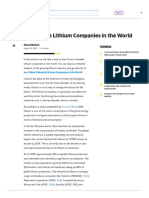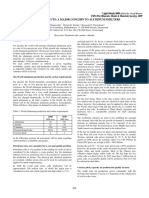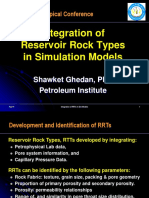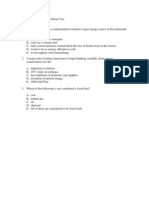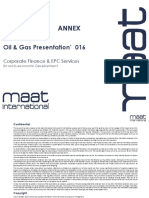Mcs 2015 Lithi
Mcs 2015 Lithi
Uploaded by
IshanSaneCopyright:
Available Formats
Mcs 2015 Lithi
Mcs 2015 Lithi
Uploaded by
IshanSaneOriginal Description:
Copyright
Available Formats
Share this document
Did you find this document useful?
Is this content inappropriate?
Copyright:
Available Formats
Mcs 2015 Lithi
Mcs 2015 Lithi
Uploaded by
IshanSaneCopyright:
Available Formats
94
LITHIUM
(Data in metric tons of lithium content unless otherwise noted)
Domestic Production and Use: The only lithium mine operating in the United States was a brine operation in
Nevada. Two companies produced a large array of downstream lithium compounds in the United States from
domestic or South American lithium carbonate, lithium chloride, and lithium hydroxide. Domestic production was not
published to protect proprietary data. A U.S. recycling company produced a small quantity of lithium carbonate from
solutions recovered during the recycling of lithium-ion batteries.
Although lithium markets vary by location, global end-use markets are estimated as follows: ceramics and glass, 35%;
batteries, 31%; lubricating greases, 8%; continuous casting mold flux powders, 6%; air treatment, 5%; polymer
production, 5%; primary aluminum production, 1%; and other uses, 9%. Lithium consumption for batteries has
increased significantly in recent years because rechargeable lithium batteries are used extensively in the growing
market for portable electronic devices and increasingly are used in electric tools, electric vehicles, and grid storage
applications. Lithium minerals were used directly as ore concentrates in ceramics and glass applications worldwide.
Salient StatisticsUnited States:
Production
Imports for consumption
Exports
Consumption:
Apparent
Estimated
Price, annual average, battery-grade lithium
3
carbonate, dollars per metric ton
Employment, mine and mill, number
4
Net import reliance as a percentage of
apparent consumption
2010
W
1,960
1,410
W
1,100
2011
W
2,850
1,310
W
2,000
2012
W
2,760
1,300
2013
1
870
2,210
1,230
W
2,000
W
1,800
2014
W
2,100
1,300
W
2,000
5,180
70
5,180
70
6,060
70
6,800
70
6,600
70
>50%
>80%
>60%
>50%
>50%
Recycling: Historically, lithium recycling has been insignificant but has increased steadily owing to the growth in
consumption of lithium batteries. One U.S. company has recycled lithium metal and lithium-ion batteries since 1992 at
its facility in British Columbia, Canada. In 2009, the U.S. Department of Energy awarded the company $9.5 million to
construct the first U.S. recycling facility for lithium-ion batteries, which was still under construction in 2014.
Import Sources (201013): Chile, 50%; Argentina, 46%; China, 3%; and other, 1%.
Tariff: Item
Other alkali metals
Lithium oxide and hydroxide
Lithium carbonate:
U.S.P. grade
Other
Number
2805.19.9000
2825.20.0000
Normal Trade Relations
123114
5.5% ad val.
3.7% ad val.
2836.91.0010
2836.91.0050
3.7% ad val.
3.7% ad val.
Depletion Allowance: 22% (Domestic), 14% (Foreign).
Government Stockpile: None.
Events, Trends, and Issues: Worldwide lithium production increased by about 6% in 2014. Production from
Argentina and Chile increased approximately 15% each in response to increased lithium demand for battery
applications. Also, in 2013, weather-related complications had reduced production for Argentinas major lithium
producer. Lithium production in Australia and China also increased. Major lithium producers expected worldwide
consumption of lithium in 2014 to be approximately 33,000 tons, an increase of 10% from that of 2013. Despite the
increased lithium demand in 2014, worldwide lithium prices, on average, remained unchanged owing to the near
balanced increase in worldwide lithium consumption and supply. Industrial Minerals reported a slight decrease in
United States lithium carbonate prices.
In the late 1990s, subsurface brines became the dominant raw material for lithium carbonate production worldwide
because of lower production costs compared with the mining and processing of hard-rock ores. Owing to growing
lithium demand from China in the past several years, however, mineral-sourced lithium regained market share and
was estimated to account for one-half of the worlds lithium supply in 2014. Two brine operations in Chile and a
spodumene operation in Australia accounted for the majority of world production. Argentina produced lithium
Prepared by Brian W. Jaskula [(703) 6484908, bjaskula@usgs.gov]
95
LITHIUM
carbonate and lithium chloride from brines. China produced lithium carbonate, lithium chloride, and lithium hydroxide
from domestic brines and, increasingly, domestic and imported spodumene. In the United States, the brine operation
in Nevada doubled production capacity in 2013. A new brine operation in Argentina was expected to be
commissioned by yearend 2014.
Recent years have seen consolidation among the handful of major lithium producers. In 2013, Chinas leading lithium
chemical producer acquired Australias leading spodumene producing facility, having a capacity of 110,000 tons per
year of lithium carbonate equivalent. In 2014, the United States-based parent company of one of Chiles brine
operations acquired 49% of the Australian spodumene operation from the Chinese chemical producer, and effectively
became the worlds leading lithium producer. Later in 2014, a U.S. bromine products manufacturer agreed to
purchase the U.S. lithium producer for $6.2 billion to create one of the worlds largest speciality chemicals
businesses.
Lithium supply security has become a top priority for Asian technology companies. Strategic alliances and joint
ventures have been, and are continuing to be, established with lithium exploration companies to ensure a reliable,
diversified supply of lithium for Asias battery suppliers and vehicle manufacturers. Several brine operations were
under development in Argentina, Bolivia, and Chile; spodumene mining operations were under development in
Australia, Canada, China, and Finland; and a jadarite mining operation was under development in Serbia. Additional
exploration for lithium continued, with numerous claims having been leased or staked worldwide.
Rechargeable batteries was the largest potential growth area for lithium compounds. Demand for rechargeable lithium
batteries exceeds that of other rechargeable batteries. Automobile companies were developing lithium batteries for
electric and hybrid electric vehicles. A leading electric car manufacturer announced plans to construct an immense
lithium-ion battery plant in the United States capable of producing up to 500,000 lithium-ion vehicle batteries per year
by 2020. The plant was expected to be vertically integrated, capable of producing finished battery packs directly from
raw materials.
World Mine Production and Reserves: The reserves estimates for Australia and Brazil have been revised based on
new information from Government and industry sources.
United States
Argentina
Australia
Brazil
Chile
China
Portugal
Zimbabwe
World total (rounded)
Mine production
e
2013
2014
870
W
2,500
2,900
12,700
13,000
400
400
11,200
12,900
4,700
5,000
570
570
1,000
1,000
6
34,000
36,000
Reserves
38,000
850,000
1,500,000
48,000
7,500,000
3,500,000
60,000
23,000
13,500,000
World Resources: Identified lithium resources in the United States total 5.5 million tons and approximately 34 million
tons in other countries. Identified lithium resources for Bolivia and Chile are 9 million tons and more than 7.5 million
tons, respectively. Identified lithium resources for major producing countries are: Argentina, 6.5 million tons; Australia,
1.7 million tons; and China, 5.4 million tons. In addition, Canada, Congo (Kinshasa), Russia, and Serbia have
resources of approximately 1 million tons each. Identified lithium resources for Brazil total 180,000 tons.
Substitutes: Substitution for lithium compounds is possible in batteries, ceramics, greases, and manufactured glass.
Examples are calcium and aluminum soaps as substitutes for stearates in greases; calcium, magnesium, mercury,
and zinc as anode material in primary batteries; and sodic and potassic fluxes in ceramics and glass manufacture.
Lithium carbonate is not considered to be an essential ingredient in aluminum potlines. Substitutes for aluminumlithium alloys in structural materials are composite materials consisting of boron, glass, or polymer fibers in resins.
e
Estimated. W Withheld to avoid disclosing company proprietary data.
Source: Rockwood Holdings, Inc., 2013 annual report: Princeton, NJ, Rockwood Holdings, Inc., p. 16.
2
Rounded to one significant figure to avoid disclosing company proprietary data.
3
Source: Industrial Minerals, IM prices: Lithium carbonate, large contracts, delivered continental United States, annual average.
4
Defined as imports exports + adjustments for Government and industry stock changes.
5
See Appendix C for resource/reserve definitions and information concerning data sources.
6
Excludes U.S. production.
1
U.S. Geological Survey, Mineral Commodity Summaries, January 2015
You might also like
- Progress On Critical Materials ResilienceDocument28 pagesProgress On Critical Materials ResilienceHoover Institution100% (1)
- Flawless Start Up - Qalhat LNGDocument12 pagesFlawless Start Up - Qalhat LNGLenaldy Nuari GarnokoNo ratings yet
- Lithium ReportDocument53 pagesLithium ReportRichard Zunk100% (1)
- Commissionning of Atlantic LNG Plant-PassingthebatonDocument12 pagesCommissionning of Atlantic LNG Plant-Passingthebatonsaminasritn100% (1)
- Li - USGSDocument9 pagesLi - USGSRodolfo LaraNo ratings yet
- Lithium Commodity ChainDocument16 pagesLithium Commodity ChainazylenbNo ratings yet
- Lithium Export DocumentsDocument8 pagesLithium Export DocumentsSiddharth PandeyNo ratings yet
- Lithium USGS YearbookDocument11 pagesLithium USGS YearbookIsmael CastroNo ratings yet
- Mcs 2019 LithiumDocument2 pagesMcs 2019 LithiumDavid ArzeNo ratings yet
- Lithium ShortageDocument14 pagesLithium ShortageAmanjit SinghNo ratings yet
- لیتیوم فلز انقلابیDocument5 pagesلیتیوم فلز انقلابیbaseoilworldNo ratings yet
- LitioDocument15 pagesLitioHubertZenonQuentaCondoriNo ratings yet
- Lithium Industry Analysis 2016Document19 pagesLithium Industry Analysis 2016lachlan_live100% (3)
- Concern Over Battery Grade Graphite SuppliesDocument2 pagesConcern Over Battery Grade Graphite SuppliesRichard J MowatNo ratings yet
- Lithium ReservesDocument2 pagesLithium ReservesROOPDIP MUKHOPADHYAYNo ratings yet
- Industria Del LitioDocument3 pagesIndustria Del LitioRocioNo ratings yet
- LITHIUM Potential Environmental Impacts of Lithium MiningDocument9 pagesLITHIUM Potential Environmental Impacts of Lithium Miningrendy1087No ratings yet
- LithiumDocument2 pagesLithiumDhruv BhattNo ratings yet
- Ithium: by Joyce A. OberDocument7 pagesIthium: by Joyce A. OberMarcelo NavarroNo ratings yet
- Lithium_MicroscopeDocument58 pagesLithium_MicroscopeLuis MeloNo ratings yet
- Informe - 468 - 18-11-2022bDocument44 pagesInforme - 468 - 18-11-2022bMadahi Katherine Garcia MedranoNo ratings yet
- China Limits Exports of Rare Earth MaterialsDocument1 pageChina Limits Exports of Rare Earth Materialscr7 bestNo ratings yet
- First Analysis Lithium Update June 2014Document31 pagesFirst Analysis Lithium Update June 2014odiegarfield100% (1)
- Carbon Products - A Major ConcernDocument3 pagesCarbon Products - A Major ConcernjaydiiphajraNo ratings yet
- Lithium Recovery - FinalDocument16 pagesLithium Recovery - FinalMohamedNo ratings yet
- 15 Most Valuable Lithium Companies in The WorldDocument8 pages15 Most Valuable Lithium Companies in The WorldextraboomNo ratings yet
- A Look at The Lithium Clay Projects - Trabajo Rec Reservas Litio Arcillas y MetalurgiaDocument10 pagesA Look at The Lithium Clay Projects - Trabajo Rec Reservas Litio Arcillas y Metalurgiaigor colladoNo ratings yet
- Lithium: Demand To Double Inside A DecadeDocument31 pagesLithium: Demand To Double Inside A DecadeResearchtimeNo ratings yet
- ETFS Investment Insights December 2016 Electric Vehicles and The Impact For Precious MetalsDocument4 pagesETFS Investment Insights December 2016 Electric Vehicles and The Impact For Precious MetalsAnonymous Ht0MIJNo ratings yet
- Building On The Strength of Our People and Our Portfolio: 2011 Annual ReportDocument160 pagesBuilding On The Strength of Our People and Our Portfolio: 2011 Annual ReportmtzakovNo ratings yet
- Part 2Document3 pagesPart 2To HLK Highschool My AmbitionNo ratings yet
- Lithium by Joice A. OberDocument6 pagesLithium by Joice A. OberMaria José FuturoNo ratings yet
- An Overview of Lithium: Geology To Markets: BY: Michael CronwrightDocument92 pagesAn Overview of Lithium: Geology To Markets: BY: Michael CronwrightVijay Wilfred100% (2)
- Facts About Graphite As A Strategic MineralDocument3 pagesFacts About Graphite As A Strategic MineralRichard J MowatNo ratings yet
- Mcs 2015 SimetDocument2 pagesMcs 2015 SimetWillian Boneli de AlmeidaNo ratings yet
- 9772 - Clean Teq LITHIUM ION BATTERIES - 17 1 17Document6 pages9772 - Clean Teq LITHIUM ION BATTERIES - 17 1 17Laurie DevilersNo ratings yet
- Gangfeng LithiumDocument13 pagesGangfeng LithiumBRIAN VICENTE VITE AGUILARNo ratings yet
- Lithium Ion Vs Silver-Zinc BatteriesDocument2 pagesLithium Ion Vs Silver-Zinc BatteriesSusan ColemanNo ratings yet
- EG Resources 10 LithiumDocument3 pagesEG Resources 10 LithiumSamikshaNo ratings yet
- Lithium in The Energy Transition More Than A Resource Issue PDFDocument10 pagesLithium in The Energy Transition More Than A Resource Issue PDFmanin1No ratings yet
- What Is The Level of Criticality of Lithium For Electrification of The Global Automobile FleetDocument20 pagesWhat Is The Level of Criticality of Lithium For Electrification of The Global Automobile Fleetcelestinjonathan1996No ratings yet
- Why The Lithium Bears Are WrongDocument16 pagesWhy The Lithium Bears Are WronghamsNo ratings yet
- IP Law Patent Landscape ReportGloballyTechINSEAD Cyrus SafdariDocument13 pagesIP Law Patent Landscape ReportGloballyTechINSEAD Cyrus SafdariHass1382No ratings yet
- Will Cheap Asian HPAL Save The EV Industry From Its Looming SuccessDocument10 pagesWill Cheap Asian HPAL Save The EV Industry From Its Looming SuccessDartwin ShuNo ratings yet
- Rare Earth Prices Soar As Efforts To Increase Supplies FalterDocument3 pagesRare Earth Prices Soar As Efforts To Increase Supplies FalterKelvin TanNo ratings yet
- PB Li Competitividade PT v6 EN PDFDocument5 pagesPB Li Competitividade PT v6 EN PDFJohnNo ratings yet
- Lithium Recovery - FinalDocument15 pagesLithium Recovery - FinalAreesh ShahidNo ratings yet
- Handes Manufacturing PLCDocument20 pagesHandes Manufacturing PLChailegiorgisNo ratings yet
- Rare Earths'Document2 pagesRare Earths'SGAL62SCRIBDNo ratings yet
- Rio Tinto Takeover of Arcadium LithiumDocument3 pagesRio Tinto Takeover of Arcadium LithiummacanudoNo ratings yet
- 0909 PDFDocument3 pages0909 PDFCris CristyNo ratings yet
- 2008 Minerals Yearbook: Ferroalloys (Advance Release)Document16 pages2008 Minerals Yearbook: Ferroalloys (Advance Release)böhmitNo ratings yet
- LithiumDocument10 pagesLithiumAnshuman TagoreNo ratings yet
- Graphite Next LithiumDocument10 pagesGraphite Next Lithiumdiego.gomesNo ratings yet
- Lithium Sediments: Jindalee Resources Limited (ASX:JRL)Document21 pagesLithium Sediments: Jindalee Resources Limited (ASX:JRL)nuseNo ratings yet
- Battery Supply Chain China Leads But What About Other CountriesDocument5 pagesBattery Supply Chain China Leads But What About Other CountriesZ pristinNo ratings yet
- Lithium Ion BatteriesDocument8 pagesLithium Ion Batteriesbob the bobNo ratings yet
- 14-Hindalco - Novelis Acquisition - Creating An Aluminium Global GiantDocument22 pages14-Hindalco - Novelis Acquisition - Creating An Aluminium Global GiantAlex WilsonNo ratings yet
- Lithium Aluminosilicate Residue As Raw Material in The Production of Sustainable Concrete Masonry Units: A Brazilian CaseDocument26 pagesLithium Aluminosilicate Residue As Raw Material in The Production of Sustainable Concrete Masonry Units: A Brazilian CaseEugênia PheganNo ratings yet
- Resources Policy: Han Hao, Zongwei Liu, Fuquan Zhao, Yong Geng, Joseph SarkisDocument7 pagesResources Policy: Han Hao, Zongwei Liu, Fuquan Zhao, Yong Geng, Joseph SarkisGaurav VermaNo ratings yet
- Summary of Guillaume Pitron's The Rare Metals WarFrom EverandSummary of Guillaume Pitron's The Rare Metals WarRating: 4 out of 5 stars4/5 (2)
- Strategic Hedging For Grain ProcessorsDocument25 pagesStrategic Hedging For Grain ProcessorsIshanSaneNo ratings yet
- Stewart McglashanDocument4 pagesStewart McglashanIshanSaneNo ratings yet
- Constantine Kosma SDocument2 pagesConstantine Kosma SIshanSaneNo ratings yet
- My Passport: StudioDocument37 pagesMy Passport: StudioIshanSaneNo ratings yet
- KURADEBhagwant (Bhupesh)Document5 pagesKURADEBhagwant (Bhupesh)IshanSaneNo ratings yet
- Nandu Madhekar: CEO at Innovative Chemical Technologies PVT LTDDocument3 pagesNandu Madhekar: CEO at Innovative Chemical Technologies PVT LTDIshanSaneNo ratings yet
- Akshay MehtaDocument9 pagesAkshay MehtaIshanSaneNo ratings yet
- Pune 1. Blades of Glory Museum 2. PL Deshpande Japanese Garden/Mughal Garden/Okayama Friendship Garden 3. Pataleshwar Gardens 4Document1 pagePune 1. Blades of Glory Museum 2. PL Deshpande Japanese Garden/Mughal Garden/Okayama Friendship Garden 3. Pataleshwar Gardens 4IshanSaneNo ratings yet
- Notes: Dropbox Folder Shared For Collaboration and WorkingDocument3 pagesNotes: Dropbox Folder Shared For Collaboration and WorkingIshanSaneNo ratings yet
- 2012 Using Mfa For SDDocument13 pages2012 Using Mfa For SDIshanSaneNo ratings yet
- Docs INSG Insight 23 Global Ebike MarketDocument6 pagesDocs INSG Insight 23 Global Ebike MarketIshanSaneNo ratings yet
- Engineering Sector in IndiaDocument10 pagesEngineering Sector in IndiaIshanSaneNo ratings yet
- CHNG3807 Products and Value Chains: Andrew HarrisDocument40 pagesCHNG3807 Products and Value Chains: Andrew HarrisIshanSaneNo ratings yet
- Australia India Business Council: AIBC Submission On Australia India Comprehensive Economic Cooperation AgreementDocument14 pagesAustralia India Business Council: AIBC Submission On Australia India Comprehensive Economic Cooperation AgreementIshanSaneNo ratings yet
- Australia India Business Council 25sept12 - 0Document11 pagesAustralia India Business Council 25sept12 - 0IshanSaneNo ratings yet
- Cumulative Percent FinerDocument2 pagesCumulative Percent FinerIshanSaneNo ratings yet
- 6 Coal Gasification IGCCDocument2 pages6 Coal Gasification IGCCIshanSaneNo ratings yet
- Kinetics and ModellingDocument12 pagesKinetics and ModellingIshanSaneNo ratings yet
- Hydrogen ProductionDocument26 pagesHydrogen Productionsorincarmen88No ratings yet
- Recycling of Aluminium Scrap For Secondary Al-Si AlloysDocument8 pagesRecycling of Aluminium Scrap For Secondary Al-Si AlloyssinrNo ratings yet
- Corrosion in The Oil and Gas Industry-An Increasing Challenge For MaterialsDocument10 pagesCorrosion in The Oil and Gas Industry-An Increasing Challenge For Materialswidjai10No ratings yet
- 025 Icest2014 A3012Document7 pages025 Icest2014 A3012Havaldar, SanjayNo ratings yet
- BPCL Sales ForecastDocument10 pagesBPCL Sales ForecastPratik LathNo ratings yet
- MLNG Dua DebottleneckingDocument10 pagesMLNG Dua DebottleneckingMarlon MoncadaNo ratings yet
- Carbon DisulfideDocument12 pagesCarbon DisulfideMelissa Daniela Romero TrujilloNo ratings yet
- AAAwpc Membership Directory - February 2012Document13 pagesAAAwpc Membership Directory - February 2012williamNo ratings yet
- Cti 20230712Document15 pagesCti 20230712kahoutgNo ratings yet
- Glenn Erwin Written StatementDocument4 pagesGlenn Erwin Written StatementNational Commission on the BP Deepwater Horizon Oil Spill and Offshore DrillingNo ratings yet
- Natural Gas PresentationDocument30 pagesNatural Gas PresentationEng Said ElsayedNo ratings yet
- ZTEK Brochure2003Document6 pagesZTEK Brochure2003cristoNo ratings yet
- Specific Heat GasDocument3 pagesSpecific Heat GasCheng Khie ChiehNo ratings yet
- Sustainable EnergyDocument5 pagesSustainable EnergyKunal VaghasiyaNo ratings yet
- Integrated Reservoir ModelingDocument24 pagesIntegrated Reservoir Modelingc_b_umashankarNo ratings yet
- Oil and Gas Management Dissertation TopicsDocument6 pagesOil and Gas Management Dissertation TopicsCollegePaperGhostWriterUK100% (1)
- FormationofSedimentaryRock HostedStratiformCopperDepositsthroughEarthHistory EG 2010 HitzmanDocument13 pagesFormationofSedimentaryRock HostedStratiformCopperDepositsthroughEarthHistory EG 2010 HitzmanPauloNo ratings yet
- APES Energy Unit Take Home TestDocument11 pagesAPES Energy Unit Take Home TestKent BrouwerNo ratings yet
- RX 8500 DataSheetDocument2 pagesRX 8500 DataSheettruongNo ratings yet
- MAAT InterventionsDocument65 pagesMAAT InterventionsHEernesNo ratings yet
- Metals and How To Weld Nickel Alloys Like Inconel 718Document39 pagesMetals and How To Weld Nickel Alloys Like Inconel 718Erick Hogan100% (2)
- IEEE CogMob 2023 Paper 34v2Document5 pagesIEEE CogMob 2023 Paper 34v2Imre ZsombokNo ratings yet
- Games Merangkumi Topik Sains Tahun 5Document60 pagesGames Merangkumi Topik Sains Tahun 5usemyknow.blogspot.comNo ratings yet
- Foster Wheeler Wins Contract For Petrochemical Refinery Complex in VietnamDocument2 pagesFoster Wheeler Wins Contract For Petrochemical Refinery Complex in VietnamJustinNo ratings yet
- Silo - Tips Hazardous Area Classification of Natural Gas InstallationsDocument94 pagesSilo - Tips Hazardous Area Classification of Natural Gas Installationssanthosh kumarNo ratings yet
- 48 Sile-2023 enDocument1 page48 Sile-2023 enArun MuraliNo ratings yet
- Stork Low NOx 2007 LRDocument6 pagesStork Low NOx 2007 LRhoangviet20006No ratings yet
- Competence Oil and GasDocument24 pagesCompetence Oil and GasAiman Hilmi Aiman HilmiNo ratings yet

























